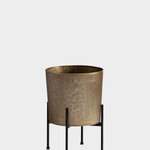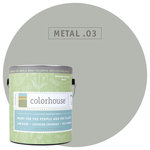Houzz TV: How to Prime a Wall Before You Paint
Primer prepares a surface for fresh paint, providing better adhesion and coverage in fewer coats. In this episode of Houzz TV, watch as decorative artist and paint expert Shauna Gallagher demonstrates how to prime walls in four scenarios: painting a dark color over light paint, covering up scribbles, going from dark to light paint and painting one dark color over another.
Keep Watching:












is there no need to sand before putting on the primer over the old paint?
I had a painter prime with tinted primer with only one finish coat. The tint used beneath was not matched to the same color....it was a bit darker, but a similar color. There are areas where I can see through the finish coat and the color looks darker than it should. I agree.....even with primer, tinted or not, two finish coats is a must. So is light sanding for adhesion and to even out any uneven surfaces. Many articles suggest not testing colors on the wall because the thickness will be different where the paint was tested.
Primer on fake wood panel - any tips or suggestions? Most walls will be light while one room (an IT home office) will go a restful cobalt blue with stark white trim.
Sand lightly due to finish on the panelling and then a stain primer like Kilz. Had several rooms in our home and this worked great!
HOW ABOUT PRIMING KITCHEN WALLS
I've always been told to have the primer tinted about the same as your finish coat, especially if you are going lighter.
Really! That is TWO coats. Primer and then the actual color. So if I painted the actual color twice it would STILL be the the same thing. . ..SO what is the point. . .
Primers are very important -- make sure to pick the correct ones. For new drywall -- make sure to get a new drywall primer. I like "first coat" from sheetrock -- it's a high body paint that masks the areas where joint compound was used ... eliminates the shiny areas. Makes the wall look uniform -- and stops the first top coat from sinking in. Outside always use a primer -- even if recoating the same color. Primer is designed to "stick" the the previous paint and provided adheasion for the top coat. I always tint my primer .... if you are going to be painting two dark colors and only need one primer get it tinted a gray. Otherwise you can tint something close to the top coat. I normally go gray as it allows me to use it for many colors.
A big mistake people make is not putting enough paint on --- don't roll or brush too much. You don't want it thick but .. . you also don't want it thin.
@ JK-I had a designer tell me to use poster board for paint samples. That way you can move them around the room so you see exactly how the paint will look even in the corners.
Wallace, the point of primer is so that the paint will retain its original color and not get sucked into the wall so much. It is a necessary preparation step so that your paint job will look as nice as possible.
Yes, you will still have to do 2 coats. But, you will not have bleed thru and you will have the color you picked out instead of....."What color is this?"
IF you painted the actual color twice it will NOT be the same thing. Just sayin'.
If you are removing wallpaper and want to paint the walls, I use Guardz by Zinnser, it covers any old paste that may still be left on the walls and give a very smoth finish to the paint.
@ A Keller - Thanks! I had my builder paint an entire sheet of drywall. We will cut it and paint sections different colors to be used in various rooms. Then we can see how the finish will also look on drywall vs. the sample or even poster board.
Jayne Polvere thanks so much for the wallpaper primer / product. I've been looking for something but haven't found anything. My new house has wallpaper in every room but 1, they even papered the pantry door and all the vents! Thanks again for the information.
Wallace, Primer is less expensive too.
If you have typical beige colored walls (generic color used in new construction through out the house) and are going over it with bright bold orange, yellow and lime green (for an energizing workout room) what type/color primer should be used, if any?
I am painting over a rust color wall with dark sand granules that were mixed in the paint. I am painting over with a beige color. Do I need to sand first or just use a primer?
What about primer & paint in one, is it just as good as doing the primer separately?